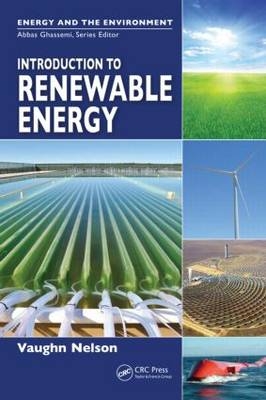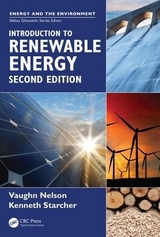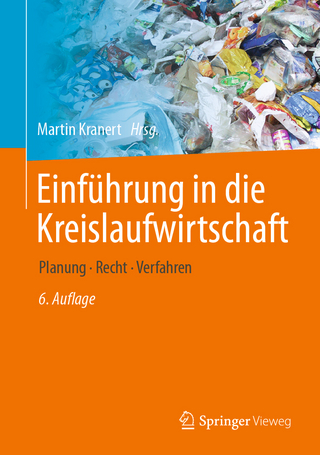
Introduction to Renewable Energy
Crc Press Inc (Verlag)
978-1-4398-3449-7 (ISBN)
- Titel erscheint in neuer Auflage
- Artikel merken
Taking a multidisciplinary approach, the book integrates economic, social, environmental, policy, and engineering issues related to renewable energy. It explains the fundamentals of energy, including the transfer of energy, as well as the limitations of natural resources. Starting with solar power, the text illustrates how energy from the sun is transferred and stored; used for heating, cooling, and lighting; collected and concentrated; and converted into electricity. A chapter describes residential power usage—including underground and off-grid homes—and houses that are designed to use energy more efficiently or to be completely self-sufficient. Other chapters cover wind power; bioenergy, including biofuel; and geothermal heat pumps; as well as hydro, tidal, and ocean energy.
Describing storage as a billion-dollar idea, the book discusses the challenges of storing energy and gives an overview of technologies from flywheels to batteries. It also examines institutional issues such as environmental regulations, incentives, infrastructure, and social costs and benefits. Emphasizing the concept of life-cycle cost, the book analyzes the costs associated with different sources of energy.
With recommendations for further reading, formulas, case studies, and extensive use of figures and diagrams, this textbook is suitable for undergraduates in Renewable Energy courses as well as for non-specialists seeking an introduction to renewable energy.
Pedagogical Features:
End-of-chapter problems
Numerous case studies
More than 150 figures and illustrations
A solutions manual is available upon qualifying course adoption
Dr. Vaughn Nelson has been involved with renewable energy, primarily wind energy, since the early 1970s; is the author of six books (five books on CD); has published over 50 articles and reports; was the principal investigator on numerous grants; and has given over 60 workshops and seminars from the local to international level. His primary work has been on wind resource assessment, education and training, applied research and development, and rural applications of wind energy. Although retired, he is still associated with the Alternative Energy Institute (AEI), West Texas A&M University (WTAMU). He was director of AEI from its inception in 1977 through 2003 and then returned for another year in July 2009. He retired as dean of the Graduate School, Research and Information Technology, WTAMU, in 2001. He taught courses in physics, participated in a joint program with other state universities of physics courses over interactive TV, and also developed online courses in wind energy and solar energy at WTAMU. Dr. Nelson developed the material for a new online course in renewable energy at WTAMU, spring 2010, and this book is the result. He is also the author of Wind Energy, Renewable Energy and the Environment (CRC Press, Boca Raton, FL, 2009). Dr. Nelson holds a PhD in physics from the University of Kansas; an EdM from Harvard University; and a BSE from Kansas State Teachers College, Emporia. He was at the Departamento de Física, Universidad de Oriente, Cumana, Venezuela, for two years and then at WTAMU from 1969 to the present. Dr. Nelson received a lifetime achievement award from the American Wind Energy Association in 2003.
Introduction
Energy and Society
Types of Energy
Renewable Energy
Advantages/Disadvantages
Economics
Global Warming
Order of Magnitude Estimates
Growth (Exponential)
Solutions
Energy
Introduction
Definition of Energy and Power
Heat
Thermodynamics
Energy Dilemma in Light of the Laws of Thermodynamics
Use of Fossil Fuels
Nuclear
Finite Resource
Summary
Sun
Solar Power
Electromagnetic Spectrum
Energy Balance of the Earth
Earth-Sun Motion
Insolation
Solar Resource
Greenhouse Effect
Heat Transfer and Storage
Introduction
Conduction
Convection
Radiation
Thermal Mass
Seasonal Heating or Cooling
Thermal Comfort
Solar Heating and Cooling
Building
Passive
Windows and Glazing
Passive Heating and Cooling
Active Heating
Active Cooling
Daylighting
Hybrid and Other
Drying Agricultural Products, Lumber
Solar Cookers
Water Purification
Photovoltaics
Introduction
Physics Basics
Energy Bands
Photovoltaic Basics
Performance
Design Considerations
Installed Capacity and Production
Applications
Comments
Concentrating Solar Power
Introduction
Power Tower
Line or Linear
Dish/Engine
Point Focus
Solar Pond
Solar Systems
Introduction
Passive Systems
Hybrid Systems
Active Systems
Underground Homes
Computer Software
Other
Wind Energy
Introduction
Wind Resource
Wind Turbines
Wind Farms
Small Wind Turbines
Village Power
Wind Diesel
Other
Performance
Comments
Bioenergy
Introduction
Conversion
Heat and Power
Biofuels
Comments
Geothermal Energy
Introduction
Resource
Types of Geothermal Resources
Direct Use
Geothermal Heat Pumps
Electricity
Comments
Water
Introduction
World Resource
Hydroelectric
Turbines
Water Flow
Tides
Ocean
Other
Storage
Introduction
Pumped Hydro
Compressed Air
Flywheels
Batteries
Other Storage Systems
Hydrogen
Institutional Issues
Introduction
United States
Regulations
Environmental Issues
Politics
Incentives
Externalities (Social Costs/Benefits)
Transmission
Economics
Introduction
Factors Affecting Economics
Economic Analyses
Life-Cycle Costs
Present Worth and Levelized Costs
Externalities
Project Development
Cost (Value) of Energy, Different Sources
Summary
The Future
Appendix
A1 Mathematics
A2 Conversion
A3 Resistance to Flow of Heat
Index
Each chapter contains references, recommended resources, and end-of-chapter problems.
| Zusatzinfo | at least 40 equations; 39 Tables, black and white; 243 Illustrations, black and white |
|---|---|
| Verlagsort | Bosa Roca |
| Sprache | englisch |
| Maße | 156 x 234 mm |
| Gewicht | 726 g |
| Themenwelt | Naturwissenschaften ► Biologie ► Ökologie / Naturschutz |
| Naturwissenschaften ► Physik / Astronomie | |
| Technik ► Elektrotechnik / Energietechnik | |
| ISBN-10 | 1-4398-3449-0 / 1439834490 |
| ISBN-13 | 978-1-4398-3449-7 / 9781439834497 |
| Zustand | Neuware |
| Informationen gemäß Produktsicherheitsverordnung (GPSR) | |
| Haben Sie eine Frage zum Produkt? |
aus dem Bereich



